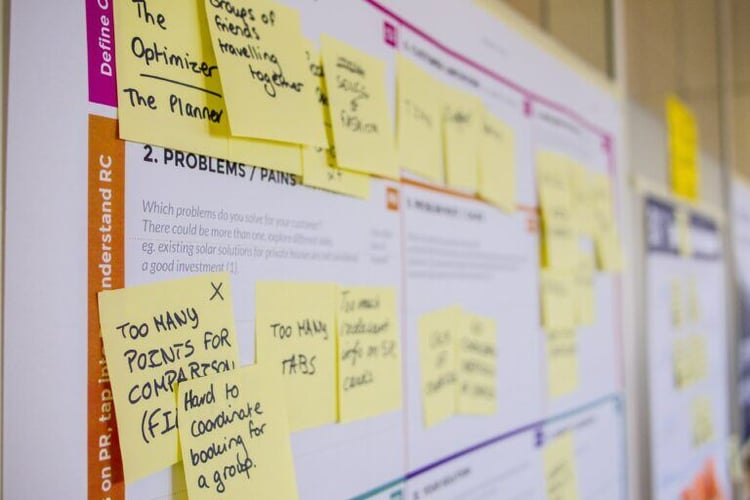Key HR Trend Six: Technology Helps Break Barriers In HR (and Skills) Strategy

Welcome back to the Skillcentrix Executive’s Team list of the Key Trends in HR, Talent, and Skills strategies you need to know this year.
As a reminder, so far, we’ve covered: Trend #1: HR Leaders Must Develop Recession-Proof Talent Strategies; Trend #2: A New CHRO Mandate Emerges (to Drive Digital Transformation and Evolving Business Mandates); and Trend #3: Talent and Skills Strategies Emerge As Crucial Competitive Advantages, Trend #4: Agile Comes to Manage the Workforce, and Trend #5: Transformative Technologies Changing HR.
Today’s your lucky day — whether you hail from the Emerald Aisle or not – because the final installment of key HR trends in 2023, means we’re turning our eyes to the marriage of HR strategy with tech.
Now, we know… For many HR and Talent leaders, the tech landscape and experience can be the opposite of finding a pot of gold. Operational challenges like a lackluster implementation, getting a “cost center” budget despite your strategic mandate, and, for many, the inherent confusion and complications that come with the saturated, or the continually evolving, talent software market can make integrating technology and strategy a giant headache.
Despite these hurdles, in 2023, successful HR programs demand a deeper understanding of how technology can empower and enable your talent and business goals. You need a vision, of course, whether you’re two years into a workforce modernization program, or just trying to figure out where to start.
But vision is only the idea; technology is how you get there.
The Five HR Tech Questions You Need to Answer in 2023
We’d love to see the secret IT decoder ring that will let you engage and support your business stakeholders, and ultimately, all your internal teams, but sadly there is not.
Instead, we took a stab at decoding the thorniest IT pitfalls, we went back to our Skillcentrix experts and picked their brains on the most critical technology questions that leaders inside HR organizations need to be ready to answer.
- Are you approaching your HR strategy as an ecosystem?
- Are you engaging in Strategic Workforce planning?
- Are you executing Skills Strategies?
- Are you linking skills adoption to business outcomes?
- Are you tracking employee mobility with the right tools in place?
Whatever your goal, from Org Design to Workforce Planning, or Talent strategy and Skills Adoption, our experts recommend every HR leader should consider these questions above and get ready with an answer (for yourself and your business partners) regarding your HR tech program for the coming year (and beyond).
I. Are you approaching your HR strategy as an ecosystem?
You’d be hard-pressed to find anyone in modern organizations enthusiastically cheering on business silos — with the possible exception of the intelligence community.
But particularly in a hybrid workforce, siloed thinking is not just sub-optimal, it’s expensive. Rigid hierarchies can ultimately reduce employee experience, reduce needed corporate agility, force leadership to re-litigate important business priorities, and can cost as much as 450,000 hours wasted annually repeating work, according to a recent Starmind report.
A grace note for those looking to embrace technology transformation is that, in fact, an effective data layer and strong workflows can act as unifying glue creating a single, integrated HR organization.
By developing a modern, up-to-date integrated ERP, you allow for the flow of data across all of the HR functions, leveraging business unit data, and back again. The data becomes the glue connecting HR strategy and disparate groups or departments.
By reducing organizational silos, you create the opportunity to affect more transformational change, more quickly. From improving your strategic workforce planning to pivoting to an actual skill-centric organization, half the battle of driving true transformation is getting everyone rowing in the same direction and speaking the same language.
II. Are you engaging in Strategic Workforce planning?
Your workforce plan can be one of your most critical competitive tools in the modern enterprise quiver. But, as the world changes around us in March of 2023, there’s a bit more nuance required in developing today’s workforce vision. Of all the resources out there, Workday offered a succinct summary of the power of what a workforce plan can be in a recent HBR article:
“Workforce planning is more than budgeting for, attracting, and hiring talent. It’s about supporting your entire workforce – building an intelligent feedback mechanism between your current and future business interests and the acquisition, retention, and development of the employees who will drive those interests. When you build sophisticated connections between your shifting talent requirements and your available resources, you’re giving your organization freedom to solve ambitious strategic challenges.” – HBR, Stepping Up Workforce Planning Strategy by Closing the HR-Finance Gap
The driver, of course, behind the need to solve these ambitious new challenges is the accelerating pace of change around us – which hasn’t seemed to slow down in a decade or two!
But new market changes, competitive pressures, products/services provided, and/or a change in strategy (finding teams with the capacity for diversified equity stakes versus debt investments if you’re a bank, for example) will inevitably impact your approach to hiring, training and the end-to-end talent lifecycle.
No longer set-it-and-forget-it, today’s workforce planning is shifting into shorter (perhaps continual) sprints of 6-18 months, as opposed to a three-to-five-year process. That’s because HR is being asked to operate even more in tune with the evolution of the business, and help support new product lines, changing staffing sizes, large shifts in employee populations (geographically and/or demographically), etc.
No matter the initiative, another vital element to success is understanding what additional or re-prioritized skills are needed internally. Employee population changes will drive the amount of (and type of) effort required to ensure the team is at the right skill level to support the business. For example, are we adding value-based selling training to already-experienced Sales Managers, or trying to train a different cohort of junior consultants into client-facing roles? Similarly, the need to move a lot faster means that skills of operating in ambiguity and dealing with quick failures need to be more prevalent throughout your org.
Aligning with our Question 1 above, workforce planning is a cross-team sport. You just won’t successfully implement your strategic workforce plan without embracing HR as an ecosystem instead of a series of silos.
How do you know who you are going to develop and how that will impact recruiting plans? TD and TA need to coordinate. Also, if you want to bind individuals or groups because they are too valuable to lose, you will need to get compensation and total rewards involved. If you want to Boost – you need to have a strong performance management system that is capturing data for you … and then applying that along with required compensation. There will be skill gaps for any promotion, so TD will need to understand the requirements to close.
Your tech backbone can significantly reduce those silos and facilitate sharing of that information. Further, if you’re struggling to get the right skills in the right place, then strategic workforce planning should likely be your next move. This type of planning becomes the result of setting up your core HCM system (Workday) with the right foundation across, jobs, employee profiles, skills, etc. which can then drive a deeper and more strategic view of your employee population and gaps.
III. Are you executing Skills Strategies?
As part of our name and one of the foundations of our company, we’ve talked a lot about skills in our Key Trends Blogs, including allocating a whole trend (#3) to the idea that Talent and Skills strategies serve as crucial competitive advantages in your overall business plan.
As a quick recap: Skills strategy helps you better understand your employees and workers by leveraging an additional data layer — skills — to understand what people actually do in their roles, and what makes them successful.
As we said before, nearly every step on your talent journey gets better with a clearer understanding of what capabilities your team has, and what gaps you need to find and grow.
But skills strategy is both an HR vision and a technology and data foundation, implementation, and engagement program. The jobs-to-skills transformation is underpinned and enabled by technology. The companies who ignore the new skills cloud fundamentals, and don’t align their HR tech to enable their HR vision, won’t actually be able to enact that vision, because they don’t have the right backbone.
Once the organizational commitment has been made to move to a skill-centered talent management approach, HRIS needs to be brought into the fold to plan and architect how the underlying solutions can support the needs of the business. Setting the right Core HCM Foundation is critical to achieving broader skills transformation.
How do you evaluate how your Skills Tech stack is looking? Here are a couple of follow-up questions to evaluate how holistically you are addressing skills.
- Do you have skills cloud-enabled?
- If so, what’s the engagement?
- Are employees self-selecting their relevant skills to help in self-serve their career growth aspirations?
From there it is about starting small and prioritizing the department, business unit, or team that has the biggest need and implementing accordingly. A quick, focused win will do wonders for gaining the organizational visibility and momentum necessary to support the transformation.
And don’t forget your change management and engagement strategy. Luckily, platform advances today mean your HR Tech footprint, roadmap, and implementation plan can also have a terrific user and employee experience – which can significantly improve overall adoption.
Finally, remember, you’re on a talent strategy journey, not a sprint. Especially in large organizations, it can be hard to make what feel like hairpin turns. It takes a delicate balance and organizational alignment to address foundational problems — without feeling like your taking steps back or slowing down forward momentum.
But without the right foundation, your skills or talent initiative could stall out. Making the investment in getting the technical and strategic foundations will unlock exponential business value.
IV. Are you linking skills adoption to business outcomes?
Okay, we’ve agreed to adopt a more holistic skills foundation across the organization, tech-enabled our workforce plan, and ensured our HCM has the right configuration to support our vision. Now what?
Now we need to share that vision with your Business Partners, to get them on board, and drive real value for our evolving business outcomes. Because for a skills paradigm to work, it can’t live as a business-only or HR-only exercise. Developing a skills-centric organization requires a full partnership between HR and the business.
To keep the BUs engaged, at a bare minimum, you have to be able to find, track and/or re-organize the people with the skills the business is looking for, and then evaluate your ability to mobilize and retain them to support your business aspirations.
Be prepared to address a host of specific, tactical results. For example, how skills strategies are working to keep the tech centers remote? What is required? How are the building skills? Are NPS scores falling? Is it worth the change? Have you improved performance or succession requirements? (There will likely be more, but you get the idea…)
If this approach is really new to your organization, think about rolling it out using elements of an agile mindset. A lot of firms are leveraging a “prototype and test” model in one “bought-in” Business Unit, ahead of rolling it out company-wide. This allows you to find and fix the kinks, as well as create and socialize employee advocates, ahead of rolling your skills programs out to manage your entire workforce ecosystem.
To enhance adoption, promote the sharing of skills in non-traditional ways to make skills “stick.” Create blended teams of cross-functionals where one member of that team is stronger in a given skill to showcase effectiveness and cross-unit collaboration.
Further, don’t rely on standard skills training. Teach leaders in the organization how to spot skills deficiency symptoms and how to coach/structure work to help develop skills in employees without taking them off the “shop floor.”
Another note on timing and agility: Your skills program shouldn’t be an annual process. For more volatile areas of the business, the skills strategy rollout and effectiveness should be reviewed (together), and adjusted as needed, at least quarterly.
V. Are you tracking employee mobility with the right tools in place?
One of the hottest topics organizations are striving to address this year is also one of the hardest to get right: Internal mobility strategy. This comes into play as both a question of having the right tools in place, but also one of encouraging participation from the business.
Do your BU partners realize the ROI of a successful internal mobility approach? Some examples you can share to drive understanding and engagement include decreased recruiting costs, lower attrition, reduced times to hire and ramp, filling skill gaps with internal employees, improved succession planning, and improved employee engagement and sentiment.
According to CNBC, 86% of employers say they are looking internally to fill open roles, and 90% of large companies feel their employees have enough opportunities to job-hop within their organization. And yet, a recent Workday article indicates that more than half of employees didn’t look internally for their next role.
Connecting, and socializing, the resources your team has available for them to self-serve their own growth can help to bridge that disconnect. As we’ve discussed above, leveraging Skills Cloud can unlock a host of critical talent management opportunities, including:
- Connecting performance management to growth opportunities (and the gaps between someone’s existing skills and the roles they’re trying to grow into).
- Developing more flexible career paths and educating both your employees and managers on what’s possible in developing a career.
- Posting growth opportunities in Gigs, or establishing an internal talent marketplace, allowing employees to self-serve their own career progression.
- Creating dynamic mentorship opportunities with a new and broader view.
One caveat: This isn’t only a tech purchase, it’s also the rollout. How you turn on and off the features is vitally important.
In fact, most stalled or failed HR transformations we see in organizations come when teams have decoupled or siloed their tech and strategy. In consulting, we like to say that it’s never the technology that fails us in transformation initiatives, it’s almost always a lack of strategy, planning, or change management that trips up otherwise intelligent architecture.
Shifting to Skills-Centric, Tech-Centric Org Means Overcoming the Fear of Change
There are some great new advances in Skills and Talent Platforms right now, including improved UX, pre-built workflows, and all the AI bells and whistles that could feel tantamount to finding that pot of Gold we talked about in the intro. Understanding what they are, and how to leverage them means your HR team can get so much more aligned, proactive, and effective in your recruiting, sourcing, mobilization, and rewards programs (and more)!
Depending on your point of view, this is either an incredibly fascinating or completely terrifying time to be in the employment world. As the recent backlash articles decrying that “ChatGPT is coming for your jobs” indicates, not everyone is comfortable with the accelerating pace of technology happening in the world right now.
But, if the leaders feel trepidation about what’s the next, next, just imagine how our teams feel.
Because this change is not going to stop, so someone has to stand up, embrace this change (or at least support people as they process through their change resistance), celebrate how much extra time teams will have to do higher-value work through automation, and help the company live the change they need to see in their orgs.
Isn’t it terrific that HR leaders happen to sit in the exact right chairs to do just that?


